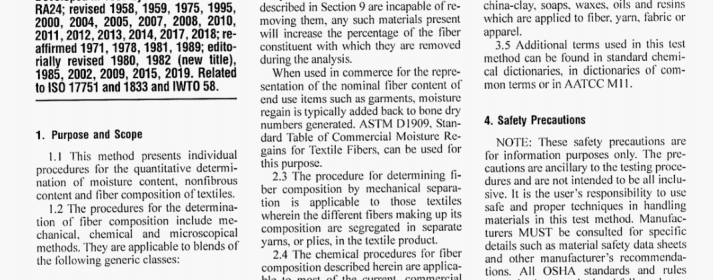Test Method for Fiber Analysis: Quantitative

AATCC TM20A-2018 pdf free.Test Method for Fiber Analysis: Quantitative.
14.1.4 Croxs-Scctinns of Cut-resistant Fiheji or Yams: For yarns containing highly cut resistant fibers that cannot be readily scparated by mechanical or chcmical means (e.g. blends containing aramids and/or polyhcn,imidazole). do not usc the fiber cutting techniqucs described in AATC(’ TM2O. Section 9.3. Mount representative yams from the sample onto the rigid mounting card using double sided tape. Coat the inside surlaccs of the sample cup with epoxy release agent. Place rigid mounting card, with sample atlixed. into the sample cup taking care to keep the card centered and perpendicular. Mix epoxy resin and epoxy hardener according to manufacturer’s instructions and Jill the sample cup. Place sample cup containing samples and resin into vacuum chamber and evacuate to a vacuum pressure of 25 in-hg for 10 minutes Slowly release vacuum pressure and cure epoxy in standard atmospheric conditions according to manufacturer’s instructions (typically 18-24 h). Remove cured epoxy mount from sample cup and cutaway top tabs of rigid mounting card. Starting with 121) grit abrasive disc affixed to grinderf polisher platen. grind surface to a smooth finish, free of indentations. Gradually increase the grit rating (going to fincr grit) of the abrasive disc, grinding/polishing to a smooth (scratch-lice) clear finish on the epoxy mount. Mounted lihers are then counted acconiing to 14.2.
14.2 !‘ihcr Counting.
14.2.1 Fibers Viewed Through Microscope: Place the slide prepared as in 14.1 on the moveaNe stage on a microscope equipped with a crosshair ocular and having a magnilication of 20O-25O Begin 10 count near either the upper or lower corner of thc field and, as the slide is moved slowly across the held in the hori,onta l direction, identify and count all fihers passing through the center of the crosshairs. After each trip acniss the field. mo’.e the slide 1.2 mm vcrtically and identify and count the fibers as the field is again traversed. Repeat this procedure until the whole slide has been coyerect. The spacing bctwccn cach traverse is dependent upon the number of fiber sections on the slide. If a fiber passes the aosshair more than once, record each passing (see 17.11). lnasimilarmwincr. count the fibers by moving the slide vertically. The combined hori,ontal and vertical counts should boil at least 1000 fibers.
14.2.2 Projected Images of Fibers; Calibrate the microprojeetor so that it will give a magni lication of 500x in the plane o the projected image. .1.0 do this, place a agc micrometer (having units of 0.01 mm) on the stage of the micro- projector with it.s scale toward the ohjcctivc and pLace a large sheet of white, non- glare paper in the projection plane. Lower or raise the microscope until an interval of 0.20 mm on the stage micrometer will measure lOt) mm when sharply focused in the center of’ the paper. Place the slide prepared as in 14.1 on the stage of the micropmjcctoc with the cover glass toward the objective. Drass a I 0-cm diameter circle in the center of the white paper in the projection plane. All meaurements and counts are to be made within this circle. Begin to count near either the upper or lower corner of the field and proceed csactty as described in 14.2.1 (sec 17.12).
14.2.3 Video Imaging of Fibers: Using a video monitor with a crosshair placed in the Center of thc screen coupled to a video camera attached to a correctly adjusted transmitted light microscope scan thcslide as outlined in 14.2.1.
14.3 Fiber Measurement.
14.3.1 Fibers with Noncircular Cross Sections:
14.31.1 Paper iracing Method: Prcparc a slide as described in 14.1.3. Place this slide on the stage of the micruprojecbr and project the image onto a sheet of graph paper having onc millimeter squares. Trace the image of the libers on the graph paper using a sharpened pencil. taking care not to retrace fibers previously traced. If these arc not sufficient Ii- hers on the slide to provide 100 of each type. prepare another slide as described above using another tuft of fibers. Continue to trace and to count on the new slide until 100 fibess of each type have been tallied. By counting squares. and parts of squares, determine the cross- sectional area of each individual IThCI of each type. Calculate the mean Cross- sectional area fir each fiber type present by summing the individual values ncorded for that type and dividing the sum by the total number of lihers of that type measured. Final values should he in mm2.
14.3.1.2 Digital Tracing Method: Prepare a slide as described in 14.13. AATCC TM20A pdf download.Test Method for Fiber Analysis: Quantitative